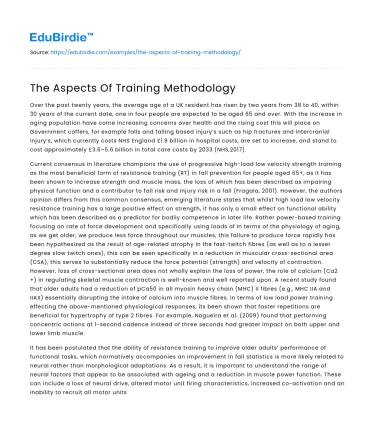Over the past twenty years, the average age of a UK resident has risen by two years from 38 to 40, within 30 years of the current date, one in four people are expected to be aged 65 and over. With the increase in aging population have come increasing concerns over health and the rising cost this will place on Government coffers, for example falls and falling based injury’s such as hip fractures and intercranial injury’s, which currently costs NHS England £1.9 billion in hospital costs, are set to increase, and stand to cost approximately £3.6–5.6 billion in total care costs by 2033 (NHS,2017).
Current consensus in literature champions the use of progressive high-load low velocity strength training as the most beneficial form of resistance training (RT) in fall prevention for people aged 65+, as it has been shown to increase strength and muscle mass, the loss of which has been described as impairing physical function and a contributor to fall risk and injury risk in a fall (Fragala, 2001). However, the authors opinion differs from this common consensus, emerging literature states that whilst high load low velocity resistance training has a large positive effect on strength, it has only a small effect on functional ability which has been described as a predictor for bodily competence in later life. Rather power-based training focusing on rate of force development and specifically using loads of In terms of the physiology of aging, as we get older, we produce less force throughout our muscles, this failure to produce force rapidly has been hypothesized as the result of age-related atrophy in the fast-twitch fibres (as well as to a lesser degree slow twitch ones), this can be seen specifically in a reduction in muscular cross-sectional area (CSA), this serves to substantially reduce the force potential (strength) and velocity of contraction. However, loss of cross-sectional area does not wholly explain the loss of power, the role of calcium (Ca2 +) in regulating skeletal muscle contraction is well-known and well reported upon. A recent study found that older adults had a reduction of pCa50 in all myosin heavy chain (MHC) II fibres (e.g., MHC IIA and IIAX) essentially disrupting the intake of calcium into muscle fibres. In terms of low load power training effecting the above-mentioned physiological responses, its been shown that faster repetitions are beneficial for hypertrophy of type 2 fibres. For example, Nogueira et al. (2009) found that performing concentric actions at 1-second cadence instead of three seconds had greater impact on both upper and lower limb muscle.
Save your time!
We can take care of your essay
- Proper editing and formatting
- Free revision, title page, and bibliography
- Flexible prices and money-back guarantee
It has been postulated that the ability of resistance training to improve older adults’ performance of functional tasks, which normatively accompanies an improvement in fall statistics is more likely related to neural rather than morphological adaptations. As a result, it is important to understand the range of neural factors that appear to be associated with ageing and a reduction in muscle power function. These can include a loss of neural drive, altered motor unit firing characteristics, increased co-activation and an inability to recruit all motor units in a given muscle. The effect of low load power-based training on neurological function is somewhat sparse, however it has been shown to increase decreased antagonist co-activation, improved motor unit firing properties and increased neural drive. Neural function is also improved to some degree for example the ability to summate (fire a lot of impulses in target muscles all at once) is improved with this form of power training as it requires maximum activation in order to create maximum force. Research highlighted improved motor unit firing and increased neural drive (Rice et al 2008) which could explain the aforementioned increase in balance. However, the idea of fast concentric actions has however been explored elsewhere, stating that neuromuscular activation was significantly lower during maximal voluntary eccentric and slow concentric contraction compared with a more standard pace. There is also some evidence that interestingly, older adults may also have a tendency to increase the type I heavy chains with regular power-based resistance training. As the force potential and velocity of contraction is highest in Type IIb and lowest in Type I fibres, these changes in the myosin heavy chains for older adults would not necessarily appear to be optimal for maximising the power response to training, it does raise the question as to whether traditional strength training is the optimal training strategy to increase older adults’ muscular power and functional performance.
For older adults, power training should consist of performing a traditional RT exercise with the concentric portion being completed as fast and with the greatest intent possible, the eccentric portion will comparatively be slower (approximately 2–3 seconds). In terms of training load research is divided. However, a general range of 40-60% 1RM is generally suggested, with movements and exercise performed incorporating whole body function. Considering safety of participant’s correct exercise progression should be considered. Conventional practise states gradual development from fixed weight-based exercise to free weight-based exercise. This effectively increases base of stability and support, the trade off being the inability to use functional movements and decreased neural drive, however as long as the movements are fast some benefit will none the less be seen.






 Stuck on your essay?
Stuck on your essay?

